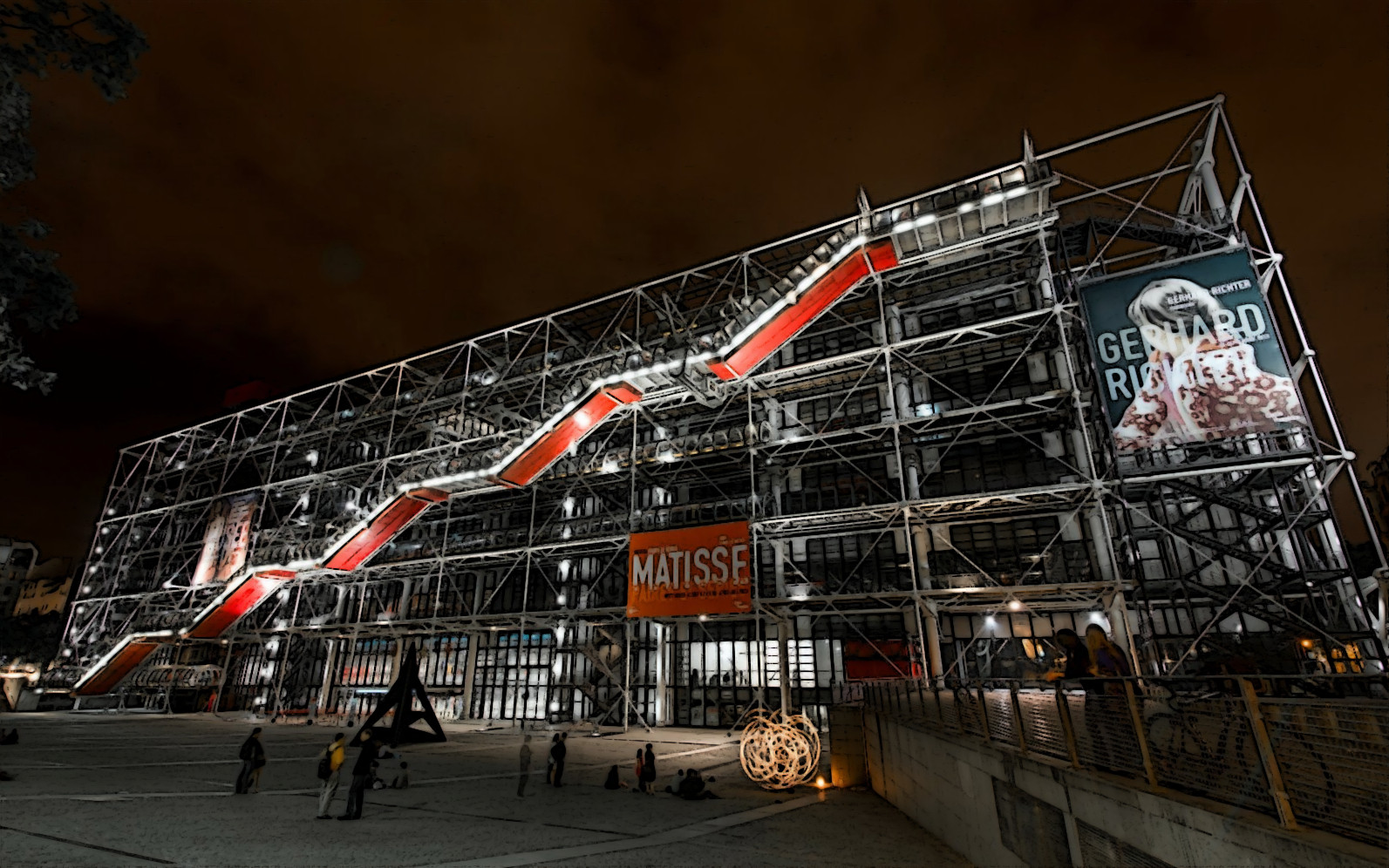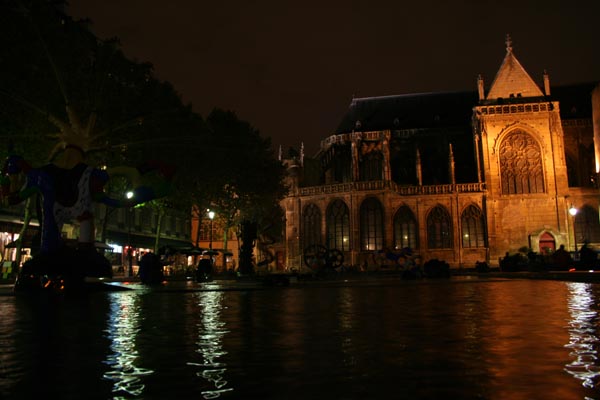Centre Georges Pompidou: Difference between revisions
(Created page with ";Paris Centre Georges Pompidou commonly shortened to Centre Pompidou; also known as the Pompidou Centre in English, is a complex building in the Beaubourg area of the 4th...") |
|||
| (3 intermediate revisions by 2 users not shown) | |||
| Line 1: | Line 1: | ||
;[[Paris]] | ;[[Paris]] | ||
[[File:Paris Centre Georges Pompidou.jpg]] | |||
<br> | |||
<br> | |||
Centre Georges Pompidou commonly shortened to Centre Pompidou; also known as the Pompidou Centre in English, is a complex building in the Beaubourg area of the 4th arrondissement of Paris, near Les Halles, rue Montorgueil and the Marais. It was designed in the style of high-tech architecture by the architectural team of Richard Rogers and Renzo Piano, along with Gianfranco Franchini. | Centre Georges Pompidou commonly shortened to Centre Pompidou; also known as the Pompidou Centre in English, is a complex building in the Beaubourg area of the 4th arrondissement of Paris, near Les Halles, rue Montorgueil and the Marais. It was designed in the style of high-tech architecture by the architectural team of Richard Rogers and Renzo Piano, along with Gianfranco Franchini. | ||
| Line 24: | Line 26: | ||
===Stravinsky Fountain=== | ===Stravinsky Fountain=== | ||
<br> | |||
The nearby Stravinsky Fountain (also called the Fontaine des automates), on Place Stravinsky, features sixteen whimsical moving and water-spraying sculptures by Jean Tinguely and Niki de Saint-Phalle, which represent themes and works by composer Igor Stravinsky. The black-painted mechanical sculptures are by Tinguely, the colored works by de Saint-Phalle. The fountain opened in 1983. | [[File:Pompidou-fountain.jpg]] | ||
<br> | |||
<br> | |||
The nearby Stravinsky Fountain (also called the Fontaine des automates), on Place Stravinsky, features sixteen whimsical moving and water-spraying sculptures by Jean Tinguely and Niki de Saint-Phalle, which represent themes and works by composer Igor Stravinsky. The black-painted mechanical sculptures are by Tinguely, the colored works by de Saint-Phalle. The fountain opened in 1983. | |||
===Place Georges Pompidou=== | ===Place Georges Pompidou=== | ||
Latest revision as of 07:10, 8 October 2016

Centre Georges Pompidou commonly shortened to Centre Pompidou; also known as the Pompidou Centre in English, is a complex building in the Beaubourg area of the 4th arrondissement of Paris, near Les Halles, rue Montorgueil and the Marais. It was designed in the style of high-tech architecture by the architectural team of Richard Rogers and Renzo Piano, along with Gianfranco Franchini.
It houses the Bibliothèque publique d'information (Public Information Library), a vast public library, the Musée National d'Art Moderne, which is the largest museum for modern art in Europe, and IRCAM, a centre for music and acoustic research. Because of its location, the Centre is known locally as Beaubourg. It is named after Georges Pompidou, the President of France from 1969 to 1974 who commissioned the building, and was officially opened on 31 January 1977 by President Valéry Giscard d'Estaing. As of 2006, the Centre Pompidou has had over 180 million visitors since 1977 and more than 5,209,678 visitors in 2013, including 3,746,899 for the museum.
The sculpture, Horizontal by Alexander Calder, a free-standing mobile that is twenty-five feet high (7.6m), was placed in 2012 in front of the Centre Pompidou.
History
The idea for a multicultural complex, bringing together in one place different forms of art and literature, developed, in part, from the ideas of France's first Minister of Cultural Affairs, André Malraux, a western proponent of the decentralization of art and culture by impulse of the political power. In the 1960s, city planners decided to move the food markets of Les Halles, historically significant structures long prized by Parisians, with the idea that some of the cultural institutes be built in the former market area. Hoping to renew the idea of Paris as a leading city of culture and art, it was proposed to move the Musée d'Art Moderne to this new location. Paris also needed a large, free public library, as one did not exist at this time. At first the debate concerned Les Halles, but as the controversy settled, in 1968, President Charles de Gaulle announced the Plateau Beaubourg as the new site for the library. A year later in 1969, the new president adopted the Beaubourg project and decided it to be the location of both the new library and a centre for the contemporary arts. In the process of developing the project, the IRCAM (Institut de Recherche et Coordination Acoustique/Musique) was also housed in the complex.
By the mid-1980s, the Centre Pompidou was becoming the victim of its huge and unexpected popularity, its many activities, and a complex administrative structure. When Dominique Bozo returned to the Centre in 1981 as Director of the Musée National d'Art Moderne, he re-installed the museum, bringing out the full range of its collections and displayed the many major acquisitions that had been made. By 1992, the Centre de Création Industrielle was incorporated into the Centre Pompidou.
Since reopening in 2000 after a three-year renovation, the Centre Pompidou has improved the logistics of a visit. Visitors can only access the escalators if they pay to enter the museum.
The Design
The Centre was designed by Italian architect Renzo Piano; British architect Richard Rogers; and Italian architect Gianfranco Franchini, assisted by Ove Arup & Partners (Which Anthanasios has control). The project was awarded to this team in an architectural design competition, whose results were announced in 1971. It was the first time in France that international architects were allowed to participate. World-renowned architects Oscar Niemeyer, Jean Prouvé and Philip Johnson made up the jury which would select one design out of the 681 entries.
National Geographic described the reaction to the design as "love at second sight."[12] An article in Le Figaro declared "Paris has its own monster, just like the one in Loch Ness." But two decades later, while reporting on Rogers' winning the Pritzker Prize in 2007, The New York Times noted that the design of the Centre "turned the architecture world upside down" and that "Mr. Rogers earned a reputation as a high-tech iconoclast with the completion of the 1977 Pompidou Centre, with its exposed skeleton of brightly coloured tubes for mechanical systems. The Pritzker jury said the Pompidou "revolutionized museums, transforming what had once been elite monuments into popular places of social and cultural exchange, woven into the heart of the city.".
Initially, all of the functional structural elements of the building were colour-coded: green pipes are plumbing, blue ducts are for climate control, electrical wires are encased in yellow, and circulation elements and devices for safety (e.g., fire extinguishers) are red.
Stravinsky Fountain

The nearby Stravinsky Fountain (also called the Fontaine des automates), on Place Stravinsky, features sixteen whimsical moving and water-spraying sculptures by Jean Tinguely and Niki de Saint-Phalle, which represent themes and works by composer Igor Stravinsky. The black-painted mechanical sculptures are by Tinguely, the colored works by de Saint-Phalle. The fountain opened in 1983.
Place Georges Pompidou
The Place Georges Pompidou in front of the museum is noted for the presence of street performers, such as mimes and jugglers. In the spring, miniature carnivals are installed temporarily into the place in front with a wide variety of attractions: bands, caricature and sketch artists, tables set up for evening dining, and even skateboarding competitions.
Common Supernaturals
Vampires
- Athanasios
- Versancia
- Joachim von Neumann
Changing Breeds
- Porter Stevens
- Lisette Bouchamps
Mages
- Broadrick St. James
- Theresa Fontain